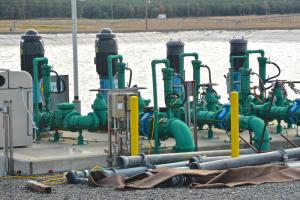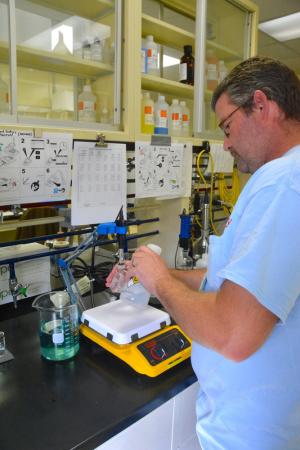Planning is critical for Sussex County officials who want to stay ahead of the curve for future sewer plant expansions and service. “It's because sewer projects are complex and take years to plan and complete,” said Mike Izzo, the county's chief engineer.
|
TREATMENT FACILITIESSouth Coastal 9 million gallons per day sludge treatment with ocean outfall Inland Bays 2.65 mgd biological nutrient removal treatment system with land application on 432 acres Wolfe Neck 3.1 mgd lagoon treatment system with land application on 306 acres of farmland owned by Delaware State Parks Piney Neck .5 mgd lagoon treatment with land application on 55 acres of farm land and loblolly pines; 12-million gallon storage lagoon |
To preserve capacity at one of its four wastewater treatment plants, Sussex County officials are embarking on a $14 million project that includes a new state-of-the-art pump station and nearly 9 miles of 24-inch sewer pipe.
The project will provide the infrastructure to divert wastewater from the county's Wolfe Neck treatment plant near Cape Henlopen State Park to the Inland Bays plant near Long Neck. It will also provide sewer hookups for projects in the area around Cedar Grove Road and Route 24 between Lewes and Rehoboth Beach including the new Cape Henlopen School District elementary school, a proposed Delaware State Police Troop 7 and a proposed RV campground project. Sussex County Council has not yet voted on the RV park project.
Capacity is a concern at the land-locked Wolfe Neck plant, Izzo said.
While even on the busiest summer weekends, the plant does not reach its permitted capacity, land is limited for spraying treated water, and the Wolfe Neck plant has little to no room to expand.
The county could expand the Wolfe Neck plant, Izzo said, "but there is no way to expand spray irrigation." The county leases the land from the state and sprays on 310 acres near Cape Henlopen State Park, not far from the Junction and Breakwater Trail.
At the Inland Bays facility, on the other hand, the county has purchased 2,000 acres for expansion.
This project to divert wastewater to the Inland Bays plant comes on the heels of another major project to expand the Angola Neck sewer district. The nearly $6 million project includes more than 3 miles of 8-inch gravity sewer pipes and 2.5 miles of force main. The project serves an area along Route 24 from Love Creek to Peddlers Village extending north to include the communities of Love Creek Woods and Fox Hollow.
Construction of central sewer in this area will eliminate more than 250 on-site septic systems.
In addition, current and planned work at the Inland Bays treatment plant will double its capacity to 5.4 million gallons within the next two decades.
A break-even venture
Sewer treatment is big business for Sussex County government, yet the entire venture is designed to break even, Izzo said. The county's goal since it started providing central sewer in the 1970s has been to eliminate existing, on-site septic systems, particularly in the Inland Bays Watershed. In many cases, the systems were in disrepair and were failing, releasing pollutants into the environment.
The county operates four wastewater treatment facilities: Wolfe Neck between Lewes and Rehoboth Beach; Inland Bays near Long Neck; South Coastal near Bethany Beach; and Piney Neck near Dagsboro.
Three of the four plants use a lagoon system and then spray irrigation to dispose of wastewater while South Coastal has used ocean outfall since 1976. A 6,200-foot, 30-inch pipe pumps treated water out into the Atlantic Ocean. The Town of Selbyville has also tied into the South Coastal system.




















































